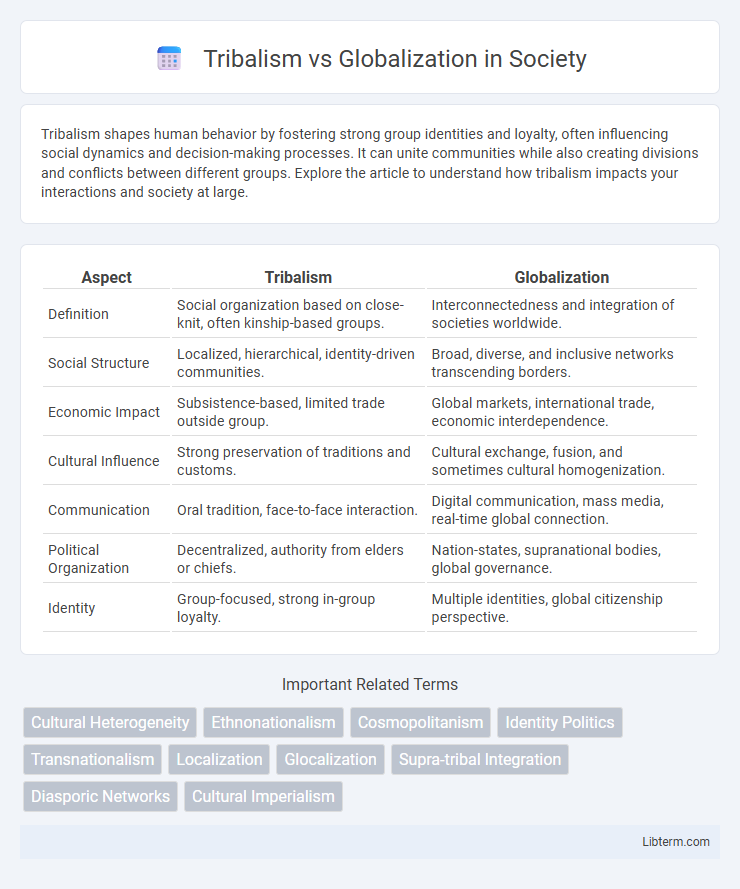Tribalism shapes human behavior by fostering strong group identities and loyalty, often influencing social dynamics and decision-making processes. It can unite communities while also creating divisions and conflicts between different groups. Explore the article to understand how tribalism impacts your interactions and society at large.
Table of Comparison
| Aspect | Tribalism | Globalization |
|---|---|---|
| Definition | Social organization based on close-knit, often kinship-based groups. | Interconnectedness and integration of societies worldwide. |
| Social Structure | Localized, hierarchical, identity-driven communities. | Broad, diverse, and inclusive networks transcending borders. |
| Economic Impact | Subsistence-based, limited trade outside group. | Global markets, international trade, economic interdependence. |
| Cultural Influence | Strong preservation of traditions and customs. | Cultural exchange, fusion, and sometimes cultural homogenization. |
| Communication | Oral tradition, face-to-face interaction. | Digital communication, mass media, real-time global connection. |
| Political Organization | Decentralized, authority from elders or chiefs. | Nation-states, supranational bodies, global governance. |
| Identity | Group-focused, strong in-group loyalty. | Multiple identities, global citizenship perspective. |
Defining Tribalism and Globalization
Tribalism refers to strong loyalty and identification with a specific social group, often characterized by shared customs, language, and traditions that shape collective identity and influence behavior. Globalization denotes the increasing interconnectedness and interdependence of nations through the exchange of ideas, goods, and cultural practices, driven by advancements in technology, communication, and trade. While tribalism emphasizes local or group-based bonds, globalization promotes broader integration and cross-cultural interaction on a global scale.
Historical Evolution of Tribal Societies
Tribal societies historically developed as small, kin-based communities with shared customs and traditions that fostered strong social cohesion and identity. Over time, advancements in agriculture, trade, and technology facilitated interactions beyond tribal boundaries, gradually contributing to the emergence of larger political entities and early forms of globalization. This shift from isolated tribalism to interconnected societies laid foundational frameworks for modern global networks and cultural exchanges.
The Rise of Globalization in the Modern Era
The rise of globalization in the modern era has accelerated through advances in technology, international trade, and cross-border communication, fostering interconnected economies and multicultural exchanges. Global institutions like the United Nations and World Trade Organization play critical roles in facilitating cooperation among nations and managing global issues such as climate change and economic development. Despite these advances, tribalism persists as communities emphasize cultural identity, local traditions, and political sovereignty in response to rapid global integration.
Core Values: Community vs Cosmopolitanism
Tribalism centers on core values such as loyalty, tradition, and a strong sense of community identity that fosters social cohesion within distinct groups. In contrast, globalization promotes cosmopolitanism, emphasizing universal values, cultural openness, and interconnectedness across diverse societies. The tension between these paradigms influences social dynamics, shaping how individuals prioritize local belonging versus global citizenship.
Economic Impacts: Local Sustainability vs Global Integration
Tribalism emphasizes local sustainability by promoting community-based economies that prioritize indigenous resources and self-reliance, which can protect regional jobs and preserve cultural heritage. Globalization drives economic growth through global integration, enabling access to international markets, technology transfer, and economies of scale, but may risk undermining local industries and increasing economic disparities. Balancing tribalism's focus on local resilience with globalization's expansive economic opportunities is crucial for achieving inclusive and sustainable development.
Cultural Identity in a Globalized World
Tribalism and globalization represent competing forces shaping cultural identity in a globalized world, where tribalism emphasizes the preservation of ethnic, linguistic, and cultural uniqueness against the homogenizing effects of globalization. Globalization facilitates cross-cultural exchanges and economic integration, often leading to hybrid identities but also risking cultural erosion and loss of traditional practices. Cultural identity in this context becomes a dynamic interplay between maintaining heritage and adapting to global influences, highlighting the importance of cultural resilience and local agency in globalized societies.
Technology as a Bridge or Barrier
Technology acts as both a bridge and a barrier in the dynamic between tribalism and globalization. Digital platforms facilitate cross-cultural communication and collaboration, promoting global interconnectedness and shared knowledge. However, algorithm-driven echo chambers and digital divides can reinforce tribal identities and limit exposure to diverse perspectives, hindering true global integration.
Political Dynamics: Decentralization vs Centralization
Tribalism emphasizes decentralization through power distribution across local communities, fostering autonomous governance and prioritizing cultural identity. Globalization promotes centralization by integrating political institutions into interconnected systems, enhancing coordination and policy uniformity on a global scale. The tension between these dynamics shapes contemporary political landscapes, as decentralized tribal allegiances resist centralized global governance structures.
Social Cohesion and Conflict in the Age of Globalization
Tribalism reinforces social cohesion within specific cultural or ethnic groups by emphasizing shared identity and loyalty, yet it often intensifies conflicts as distinct groups compete for resources and recognition. Globalization fosters interconnectedness and broader social integration across diverse populations, promoting cross-cultural cooperation but also provoking resistance from tribal affiliations threatened by homogenization. The tension between tribalism and globalization shapes the dynamics of social cohesion, where maintaining group identity can both unite and divide societies in an increasingly interconnected world.
The Future: Balancing Tribal Roots with Global Connections
The future demands a nuanced balance between preserving tribal roots and embracing global connections, fostering cultural diversity while promoting unity. Advances in technology and communication enable stronger global networks without erasing indigenous identities. Sustainable globalization practices must respect tribal sovereignty and encourage cross-cultural collaboration for equitable development worldwide.
Tribalism Infographic

 libterm.com
libterm.com